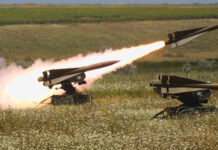Amid recriminations between Kyiv and Moscow over the breaching of the Nova Kakhovka dam on the Dnipro River in the early hours of 6 June 2023, it appears that, amid rumours of a much-heralded Ukrainian counter-offensive, it is the Russian occupying forces that stand most to gain from the breach.
The Dnipro River, which effectively cuts Ukraine in two from north to south, was already presenting a formidable obstacle for the Ukrainian counter-offensive south of Zaporizhzhia, from which point Russian forces control the river’s southwest bank. Now, with significant flooding downstream of the Kakhovka Dam, over two-fifths of the front line between Zaporizhzhia and the western extremity of Russian-occupied Ukraine has been rendered completely unviable for any counter-offensive.
It is not, of course, known exactly where the Ukrainian military planned to make their push, but the breach of the Nova Kakhovka dam now means that almost 100 km of the front line in southern Ukraine will not be somewhere Russia will have to commit forces to defending. Meanwhile, the Ukrainian government is having to preoccupy itself with mitigating the effects of a significant ecological disaster.
However, the extensive flooding caused by the Kakhovka Dam’s breach has also had a significant negative effect for the Russian occupying forces in southern Ukraine; Oleksandr Prokudin, the Ukrainian governor of Kherson, has said that 68% of the flooded territory was on the Russian-occupied bank of the Dnipro River.
Indeed, this fact has been central in Russian denials of responsibility for the attack on the dam. As well as forcing the evacuation troops as well as civilians from the southwest bank of the Dnipro downstream of Kakhovka, the flooding from the dam’s breach could also jeopardise the fresh water supply to Russian-occupied Crimea from the North Crimean Canal. Ukraine shut down the canal in 2014 soon after Russian occupied Crimea, but Russia restored the flow of water a month after its wider invasion of Ukraine in February 2022.
Any Ukrainian counter-offensive that struck southwest toward the Sea of Azov between Melitopol and Mariupol in the centre of Russian-occupied Ukraine, though extremely hazardous in the light of hardened Russian defensive lines, could threaten Russia’s continued occupation of Crimea. Loss of this peninsula would be a major strategic blow to the regime of Russian President Vladimir Putin, so any development that makes occupation of Crimea less viable must be a concern for the Russian occupying forces.

Ukrainian sources have stated that the floods from the Kakhovka Dam breach will leave hundreds of thousands of people without access to drinking water, swamp tens of thousands of hectares of agricultural land and turn at least 500,000 hectares deprived of irrigation into deserts.
Ukrainian President Volodymyr Zelensky called the incident “the largest man-made environment disaster in Europe in decades”. The Ukrainian authorities had previously warned that the failure of the Kakhovka Dam could unleash a volume of water estimated as nearly equivalent to that held by the Great Salt Lake in the US state of Utah.
Peter Felstead













